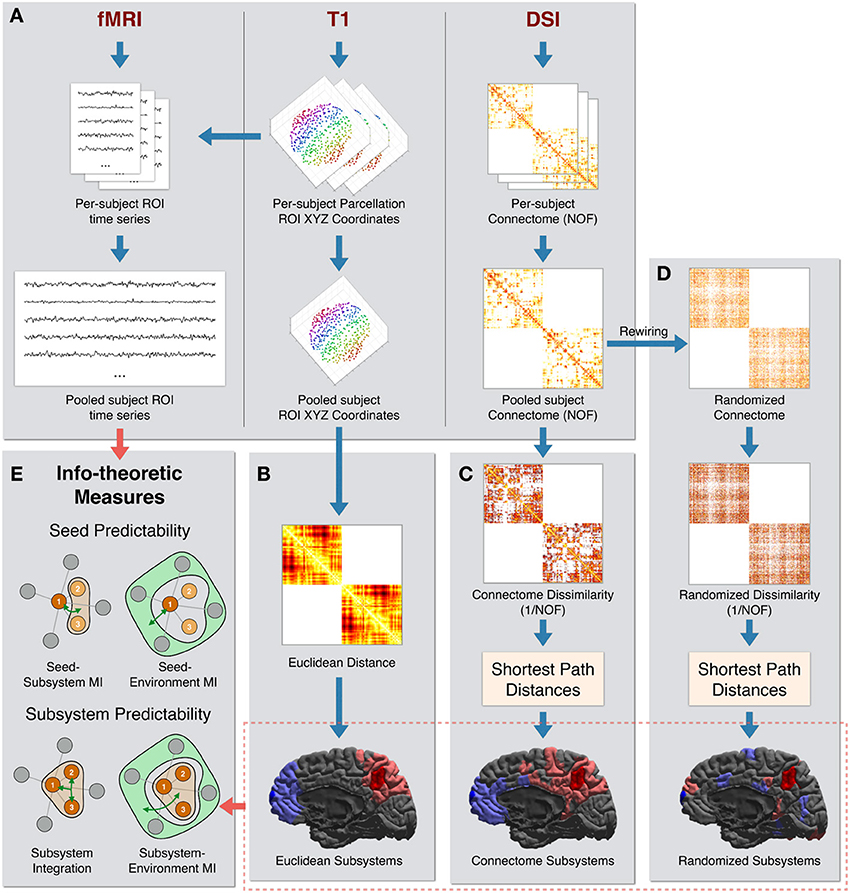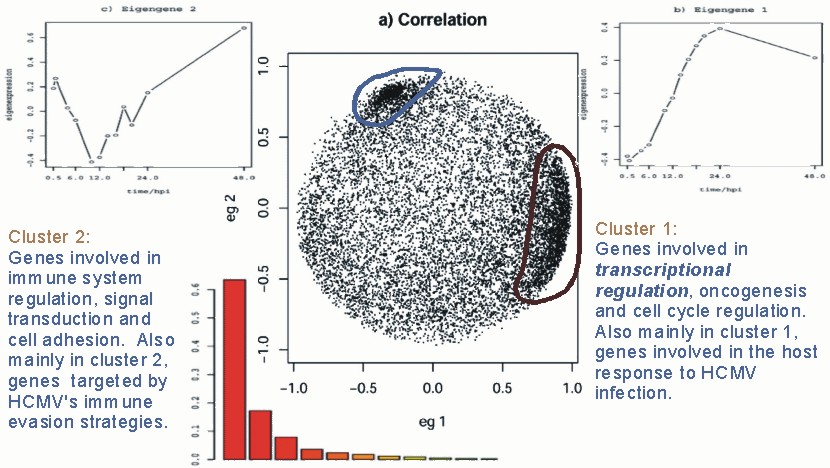Multivariate Time-Series Analysis and Network Inference
Spectral methods for genomic multivariate analysis
We have worked on clustering methods for genomic data which allow multiple membership of genes in clusters. In particular, we used spectral analysis methods, such as Singular Value Decomposition (SVD), to uncover global patterns of gene expression. We also looked at other methods such as association rule mining, fuzzy clustering, and the general systems problem solver. We wrote a “manual” for how to use SVD and the related principal component analysis, for microarray data, which included a overview of the method and some insights about its relationship to Fourrier analysis [Wall, Rechtsteiner, and Rocha ,2003]. We have applied this method to uncover novel expression patterns in human cells subjected to Human Cytomegalovirus (Herpes) infection [Challacombe, et al,2004] in a collaboration with the life sciences division at Los Alamos and the Shenk lab at Princeton University. Another thread is using SVD in the context of biomedical text mining for the automatic functional annotation of genes and proteins from the literature [Rechtesteiner, 2005; Maguitman, A. et al, 2006; Haidar et al, 2008;].

The human brain displays heterogeneous organization in both structure and function. The figure depicts a method to characterize brain regions and networks in terms of information-theoretic measures. This framework is applied to human brain fMRI recordings of resting-state activity and DSI-inferred structural connectivity. From Kolchinsky et al 2014
Multi-scale modularity and inference
More recently, we have used SVD and information theory to cluster very large knowledge networks of gene regulation obtained from bioinformatics databases and the literature. This allows us to identify overlapping functional clusters that occur in various scales of complex networks [Correia, Navarro-Costa and Rocha, 2020], such as those characterizing gene regulation. Together with our distance backbone methodology, this has lead to the discovery of novel genes involved in human infertility [Correia et al, 2022].
In addition to spectral methods, we study statistical prediction [Kolchinsky and Rocha, 2011], modularity [Kolchinsky, Gates and Rocha, 2015, Marques-Pita and Rocha, 2013], multi-scale integration in the dynamics of complex networks, such as brain networks [Kolchinsky et al 2014], and other scalable methods to study dynamics of networks [Rocha , 2022; Parmer, Rocha, & Radicchi, 2022]---for dynamics on networks see our work on distance backbones.
Project Members (Current and Former)

Luis Rocha (PI)

Alaa Abi-Haidar

Rion Brattig Correia

Alex Gates

Artemy Kolchinsky

Ana Maguitman

Thomas Parmer

Olaf Sporns

Andreas Rechtsteiner
Selected Project Publications
- R.B. Correia, J.M. Almeida, Ma.J. Wyrwoll, I.Julca, D. Sobral, C.S. Misra, L.G. Guilgur, H.-C. Schuppe, N. Silva, P. Prudêncio, A. Nóvoa, A. S. Leocádio, J. Bom, M. Mallo, S. Kliesch, M. Mutwil, L.M. Rocha, F.Tüttelmann, J. D. Becker, P. Navarro-Costa [2022]. "The conserved transcriptional program of metazoan male germ cells uncovers ancient origins of human infertility". bioRxiv 2022.03.02.482557, doi: 10.1101/2022.03.02.482557.
- Parmer, T., Rocha, L.M. & Radicchi, F. [2022]. "Influence maximization in Boolean networks". Nature Communications. 13, 3457, DOI: 10.1038/s41467-022-31066-0.
- Correia, R.B., P. Navarro-Costa, and L.M. Rocha [2020]. "Extraction of overlapping modules in networks via spectral methods and information theory". Complex Networks 2020. The 9th International Workshop on Complex Networks and Their Applications. Dec. 1-3, 2020, Madrid, Spain (Online).
- A. Kolchinsky, A. Gates and L.M. Rocha. [2015] "Modularity and the spread of perturbations in complex dynamical systems." Phys. Rev. E Rapid Communications. 92, 060801(R).
- A. Kolchinsky, M. P. Van Den Heuvel, A. Griffa, P. Hagmann, L.M. Rocha, O. Sporns, J. Goni [2014]. "Multi-scale Integration and Predictability in Resting State Brain Activity". Frontiers in Neuroinformatics, 8:66. doi: 10.3389/fninf.2014.00066.
- M. Marques-Pita and L.M. Rocha [2013]. “Canalization and control in automata networks: body segmentation in Drosophila Melanogaster”. PLoS ONE, 8(3): e55946. doi:10.1371/journal.pone.0055946.
- A. Kolchinsky, and L.M. Rocha [2011].”Prediction and Modularity in Dynamical Systems“.In: Advances in Artificial Life, Proceedings of the Eleventh European Conference on the Synthesis and Simulation of Living Systems (ECAL 2011). August 8 – 12, 2011, Paris, France,. MIT Press, pp. 423-430.
- Andreas Rechtesteiner [2005]. Multivariate Analysis of Gene Expression Data and Functional Information: Automated Methods for Functional Genomics . PhD Dissertation, Systems Science Program, Portland State University.
- Challacombe, A. Rechtsteiner, G. Gottardo, L.M. Rocha, E.P. Brown, T. Shenk, M. Altherr, T. Brettin [2004]. “Evaluation of the host transcriptional response to human cytomegalovirus infection“. Physiol. Genomics (April 6, 2004). 10.1152/physiolgenomics.00155.2003.
- Rocha, Luis M. and A. Rechtsteiner [2004]. “Review of Bioinformatics for Geneticists.” Clinical Chemistry 50 (9), pp. 2471 – 2472. CLINCHEM/2003/020909.
- Wall, Michael E., Andreas Rechtesteiner, and Luis M. Rocha [2003]. “Singular Value Decomposition and Principal Component Analysis “. In: A Practical Approach to Microarray Data Analysis. D. P. Berrar, W. Dubitzky, and M. Granzow (Eds.). Kluwer Academic Publishers, pp. 91-109.
- Rechtsteiner, A., R. Gottardo, L.M. Rocha, and M.E. Wall [2003]. “Singular Value Decomposition for Analysis of Gene Expression” (pdf). Currents in Computational Molecular Biology. Proceedings of the The Seventh Annual International Conference on Research in Computational Molecular Biology (RECOMB 2003), Berlin, April 10-13, 2003. R. Spang, P.Beziat and M. Vingron (Eds).pp. 275-276
- Rechtsteiner, A., R. Gottardo, L.M. Rocha, M.E. Wall and T. Brettin [2003]. “Three Algorithms for Filtering and Analysis of Gene Expression Data”. Poster at Pacific Symposium on Biocomputing 2003.

